Scenarios Simulation of Spatio-Temporal Land Use Changes for Exploring Sustainable Management Strategies
Abstract
1. Introduction
2. Materials and Methods
2.1. Description of the Study Area
2.2. Data and Pre-Prosessing
2.3. Model Description
2.3.1. CLUE-S Model
2.3.2. Scenarios Setting
2.3.3. Requirements for the Land Use Types
2.3.4. Model Configuration
3. Results
3.1. Validation of the Model
3.2. Land Use Demand in Different Scenarios
3.3. Spatial Simulation of Land Use in 2020
4. Discussion
4.1. Characteristics of Each Scenario Simulation
4.2. Dissemination of Scenario Consequences
4.3. Availability of the Integrated Method
5. Conclusions
Acknowledgments
Author Contributions
Conflicts of Interest
References
- Maeda, E.E.; De Almeida, C.M.; De Carvalho Ximenes, A.; Formaggio, A.R.; Shimabukuro, Y.E.; Pellikka, P. Dynamic modeling of forest conversion: Simulation of past and future scenarios of rural activities expansion in the fringes of the Xingu National Park, Brazilian Amazon. Int. J. Appl. Earth Obs. Geoinf. 2011, 13, 435–446. [Google Scholar] [CrossRef]
- Bürgi, M.; Silbernagel, J.; Wu, J.; Kienast, F. Linking ecosystem services with landscape history. Landsc. Ecol. 2015, 30, 11–20. [Google Scholar] [CrossRef]
- Han, J.; Hayashi, Y.; Cao, X.; Imura, H. Evaluating land-use change in rapidly urbanizing China: Case study of shanghai. J. Urban Plan. Dev. 2009, 135, 166–171. [Google Scholar] [CrossRef]
- Wang, X.H.; Yu, S.; Huang, G.H. Land allocation based on integrated GIS-optimization modelling at a watershed level. Landsc. Urban Plan. 2004, 66, 61–74. [Google Scholar] [CrossRef]
- Long, H.L.; Liu, Y.S.; Li, X.B.; Chen, Y.F. Building new countryside in China: A geographical perspective. Land Use Policy 2010, 27, 457–470. [Google Scholar] [CrossRef]
- Long, H.L.; Tu, S.S.; Ge, D.Z.; Li, T.T.; Liu, Y.S. The allocation and management of critical resources in rural China under restructuring: Problems and prospects. J. Rural Stud. 2016, 47, 392–412. [Google Scholar] [CrossRef]
- Lin, L.; Jia, H.Z.; Pan, Y.; Qiu, L.F.; Gan, M.Y.; Lu, S.G.; Deng, J.S.; Yu, Z.L.; Wang, K. Exploring the patterns and mechanisms of reclaimed arable land utilization under the requisition-compensation balance policy in Wenzhou, China. Sustainability 2018, 10, 75. [Google Scholar] [CrossRef]
- Wang, C.D.; Wang, Y.T.; Wang, R.Q.; Zheng, P.M. Modelling and evaluating land-use/land-cover change for urban planning and sustainability: A case study of Dongying city, China. J. Clean. Prod. 2018, 172, 1529–1534. [Google Scholar] [CrossRef]
- Tan, Y.; Xu, H.; Jiao, L.; Ochoa, J.J.; Shen, L. A study of best practices in promoting sustainable urbanization in China. J. Environ. Manag. 2017, 193, 8–18. [Google Scholar] [CrossRef] [PubMed]
- Zhang, C.; Lin, Y. Panel estimation for urbanization, energy consumption and CO2 emissions: A regional analysis in China. Energy Policy 2012, 49, 488–498. [Google Scholar] [CrossRef]
- Wu, Z.T.; Zhang, H.J.; Krause, G.M.; Cobb, N.S. Climate change and human activities: A case study in Xinjiang, China. Clim. Chang. 2010, 99, 457–472. [Google Scholar] [CrossRef]
- Feng, Y.X.; Luo, G.P.; Lu, L.; Zhou, D.C.; Han, Q.F.; Xu, W.Q.; Yin, C.Y.; Zhu, L.; Dai, L.; Li, Y.Z.; et al. Effects of land use change on landscape pattern of the Manas River watershed in Xinjiang, China. Environ. Earth Sci. 2011, 64, 2067–2077. [Google Scholar] [CrossRef]
- Xie, H.L.; Wang, P.; Yao, G.R. Exploring the dynamic mechanisms of farmland abandonment based on a spatially explicit economic model for environmental sustainability: A case study in Jiangxi Province, China. Sustainability 2014, 6, 1260–1282. [Google Scholar] [CrossRef]
- Liu, Y.L.; He, Q.S.; Tan, R.H.; Liu, Y.F.; Yin, C.H. Modelling different urban growth patterns based on the evolution of urban form: A case study from Huangpi, Central China. Appl. Geogr. 2016, 66, 109–118. [Google Scholar] [CrossRef]
- You, W.B.; Ji, Z.R.; Wu, L.Y.; Deng, X.P.; Huang, D.H.; Chen, B.R.; Yu, J.A.; He, D.J. Modelling changes in land use patterns and ecosystem services to explore a potential solution for meeting the management needs of a heritage site at the landscape level. Ecol. Indic. 2017, 73, 68–78. [Google Scholar] [CrossRef]
- Brown, D.G.; Pijanowski, B.C.; Duh, J.D. Modeling the relationships between land use and land cover on private lands in the upper Midwest, USA. J. Environ. Manag. 2000, 59, 247–263. [Google Scholar] [CrossRef]
- Jenerette, G.D.; Wu, J. Analysis and simulation of land-use change in the central Arizona-Phoenix region, USA. Landsc. Ecol. 2001, 16, 611–626. [Google Scholar] [CrossRef]
- Hathout, S. The use of GIS for monitoring and predicting urban growth in east and west St Paul, Winnipeg, Manitoba, Canada. J. Environ. Manag. 2002, 66, 229–238. [Google Scholar] [CrossRef]
- Fathizad, H.; Rostami, N.; Faramarzi, M. Detection and prediction of land cover changes using Markov chain model in semi-arid rangeland in western Iran. Environ. Monit. Assess. 2015, 187. [Google Scholar] [CrossRef] [PubMed]
- Etter, A.; McAlpine, C.; Wilson, K.; Phinn, S.; Possingham, H. Regional patterns of agricultural land use and deforestation in Colombia. Agric. Ecosyst. Environ. 2006, 114, 369–386. [Google Scholar] [CrossRef]
- Fondevilla, C.; Colomer, M.À.; Fillat, F.; Tappeiner, U. Using a new PDP modelling approach for land-use and land-cover change predictions: A case study in the Stubai Valley (Central Alps). Ecol. Model. 2016, 322, 101–114. [Google Scholar] [CrossRef]
- Xu, Q.L.; Yang, K.; Wang, G.L.; Yang, Y.L. Agent-based modeling and simulations of land-use and land-cover change according to ant colony optimization: A case study of the Erhai Lake Basin, China. Nat. Hazards 2015, 75, 95–118. [Google Scholar]
- Brandt, J.; Primdahl, J.; Reenberg, A. Rural land-use and dynamic forces—Analysis of ‘driving forces’ in space and time. In Land-use Changes and Their Environmental Impact in Rural Areas in Europe; Krönert, R., Baudry, J., Bowler, I.R., Reenberg, A., Eds.; UNESCO: Paris, France, 1999; pp. 81–102. [Google Scholar]
- Wu, Y.Z.; Peng, Y.; Zhang, X.L.; Skitmore, M.; Song, Y. Development priority zoning (DPZ)-led scenario simulation for regional land use change: The case of Suichang County, China. Habitat Int. 2012, 36, 268–277. [Google Scholar] [CrossRef]
- Paudel, S.; Yuan, F. Assessing landscape changes and dynamics using patch analysis and GIS modeling. Int. J. Appl. Earth Obs. Geoinf. 2012, 16, 66–76. [Google Scholar] [CrossRef]
- Tzanopoulos, J.; Vogiatzakis, I.N. Processes and patterns of landscape changeon a small Aegean island: The case of Sifnos, Greece. Landsc. Urban Plan. 2011, 99, 58–64. [Google Scholar] [CrossRef]
- Schweizer, P.E.; Matlack, G.R. Factors driving land use change and forest distribution on the coastal plain of Mississippi, USA. Landsc. Urban Plan. 2014, 121, 55–64. [Google Scholar] [CrossRef]
- Newman, M.E.; McLaren, K.P.; Wilson, B.S. Long-term socio-economic and spatial pattern drivers of land cover change in a Caribbean tropical moist forest, the Cockpit Country, Jamaica. Agric. Ecosyst. Environ. 2014, 186, 185–200. [Google Scholar] [CrossRef]
- Basse, R.M.; Omrani, H.; Charif, O.; Gerber, P.; Bódis, K. Land use changes modelling using advanced methods: Cellular automata and artificial neural networks. The spatial and explicit representation of land cover dynamics at the cross-border region scale. Appl. Geogr. 2014, 53, 160–171. [Google Scholar] [CrossRef]
- Greiner, R.; Puig, J.; Huchery, C.; Collier, N.; Garnett, S.T. Scenario modelling to support industry planning and decision making. Environ. Model. Softw. 2014, 55, 120–131. [Google Scholar] [CrossRef]
- Mas, J.F.; Kolb, M.; Paegelow, M.; Olmedo, M.T.C.; Houet, T. Inductive pattern-based land use/cover change models: A comparison of four software packages. Environ. Model. Softw. 2014, 51, 94–111. [Google Scholar] [CrossRef]
- Subedi, P.; Subedi, K.; Thapa, B. Application of a hybrid cellular automaton—Markov (CA-Markov) model in land-use change prediction: A case study of saddle creek drainage basin, Florida. Appl. Ecol. Environ. Sci. 2013, 1, 126–132. [Google Scholar] [CrossRef]
- Xu, X.M.; Du, Z.Q.; Zhang, H. Integrating the system dynamic and cellular automata models to predict land use and land cover change. Int. J. Appl. Earth Obs. Geoinf. 2016, 52, 568–579. [Google Scholar] [CrossRef]
- Han, H.R.; Yang, C.F.; Song, J.P. Scenario simulation and the prediction of land use and land cover change in Beijing, China. Sustainability 2015, 7, 4260–4279. [Google Scholar] [CrossRef]
- Fuglsang, M.; Műnier, B.; Hansen, H.S. Modelling land-use effects of future urbanization using cellular automata: An Eastern Danish case. Environ. Model. Softw. 2013, 50, 1–11. [Google Scholar] [CrossRef]
- Samie, A.; Deng, X.Z.; Jia, S.Q.; Chen, D.D. Scenario-based simulation on dynamics of land-use-land-cover change in Punjab Province, Pakistan. Sustanability 2017, 9. [Google Scholar] [CrossRef]
- Luo, G.P.; Yin, C.Y.; Chen, X.; Xu, W.Q.; Lu, L. Combining system dynamic model and CLUE-S model to improve land use scenario analyses at regional scale: A case study of Sanggong watershed in Xinjiang, China. Ecol. Complex. 2010, 7, 198–207. [Google Scholar] [CrossRef]
- Haase, D.; Haase, A.; Kabisch, N.; Kabisch, S.; Rink, D. Actors and factors in land-use simulation: The challenge of urban shrinkage. Environ. Model. Softw. 2012, 35, 92–103. [Google Scholar] [CrossRef]
- Theobald, D.M.; Gross, M.D. EML: A modeling environment for exploring landscape dynamics. Comput. Environ. Urban Syst. 1994, 18, 193–204. [Google Scholar] [CrossRef]
- Parker, D.C.; Manson, S.M.; Janssen, M.A.; Hoffmann, M.J.; Deadman, P. Multi-agent systems for the simulation of land-use and land-cover change: A review. Ann. Assoc. Am. Geogr. 2003, 93, 314–337. [Google Scholar] [CrossRef]
- Zhou, R.; Zhang, H.; Ye, X.Y.; Wang, X.J.; Su, H.L. The delimitation of urban growth boundaries using the CLUE-S land-use change model: Study on Xinzhuang Town, Changshu City, China. Sustainability 2016, 8, 1182. [Google Scholar] [CrossRef]
- Lu, Y.; Wang, X.R.; Xie, Y.J.; Li, K.; Xu, Y.Y. Integrating future land use scenarios to evaluate the spatio-temporal dynamics of landscape ecological security. Sustainability 2016, 8, 1242. [Google Scholar] [CrossRef]
- Britz, W.; Verburg, P.H.; Leip, A. Modelling of land cover and agricultural change in Europe: Combining the CLUE and CAPRI-Spat approaches. Agric. Ecosyst. Environ. 2011, 142, 40–50. [Google Scholar] [CrossRef]
- Trivedi, H.V.; Singh, J.K. Application of grey system theory in the development of a runoff prediction model. Biosyst. Eng. 2005, 92, 521–526. [Google Scholar] [CrossRef]
- Wang, H.; Li, X.B.; Long, H.L.; Qiao, Y.W.; Li, Y. Development and application of a simulation model for changes in land-use patterns under drought scenarios. Comput. Geosci. 2011, 37, 831–843. [Google Scholar] [CrossRef]
- Murray-Rust, D.; Rieser, V.; Robinson, D.T.; Miličič, V.; Rounsevell, M. Agent-based modelling of land use dynamics and residential quality of life for future scenarios. Environ. Model. Softw. 2013, 46, 75–89. [Google Scholar] [CrossRef]
- Liu, J.Y.; Li, J.; Qin, K.Y.; Zhou, Z.X.; Yang, X.N.; Li, T. Changes in land-uses and ecosystem services under multi-scenarios simulation. Sci. Total Environ. 2017, 586, 522–526. [Google Scholar] [CrossRef] [PubMed]
- Olaya-Abril, A.; Parras-Alcantara, L.; Lozano-Garcia, B.; Obregon-Romero, R. Soil organic carbon distribution in Mediterranean areas under a climate change scenario via multiple linear regression analysis. Sci. Total Environ. 2017, 592, 134–143. [Google Scholar] [CrossRef] [PubMed]
- Alcamo, J. Environmental Futures—The Practice of Environmental Scenario Analysis; Elsevier: Oxford, UK, 2009. [Google Scholar]
- Raskin, P.D. Global scenarios: Background review for the Millennium Ecosystems Assessment. Ecosystems 2005, 8, 133–142. [Google Scholar] [CrossRef]
- Swetnam, R.D.; Fisher, B.; Mbilinyi, B.P.; Munishi, P.K.T.; Willcock, S.; Ricketts, T.; Mwakalila, S.; Balmford, A.; Burgess, N.D.; Marshall, A.R.; et al. Mapping socio-economic scenarios of land cover change: A GIS method to enable ecosystem service modelling. J. Environ. Manag. 2011, 92, 563–574. [Google Scholar] [CrossRef] [PubMed]
- Cotter, M.; Berkhoff, K.; Gibreel, T.; Ghorbani, A.; Goblon, R.; Nuppenau, E.A.; Sauerborn, J. Designing a sustainable land use scenario based on a combination of ecological assessments and economic optimization. Ecol. Indic. 2014, 36, 779–787. [Google Scholar] [CrossRef]
- Zhang, L.W.; Fu, B.J.; Lű, Y.H.; Zeng, Y. Balancing multiple ecosystem services in conservation priority setting. Landsc. Ecol. 2015, 30, 535–546. [Google Scholar] [CrossRef]
- Xinjiang Province Statistical Bureau. Statistical Yearbook of Xinjiang Province 1999; Xinjiang Province Statistical Bureau: Xinjiang, China, 1999. [Google Scholar]
- Xinjiang Province Statistical Bureau. Statistical Yearbook of Xinjiang Province 2016; Xinjiang Province Statistical Bureau: Xinjiang Province, China, 2016. [Google Scholar]
- Zhang, Y.; Wang, T.W.; Cai, C.F.; Li, C.G.; Liu, Y.J.; Bao, Y.Z. Landscape pattern and transition under natural and anthropogenic disturbance in an arid region of northwestern China. Int. J. Appl. Earth Obs. Geoinf. 2016, 44, 1–10. [Google Scholar] [CrossRef]
- Brinkmann, K.; Schumacher, J.; Dittrich, A.; Kadaore, I.; Buerkert, A. Analysis of landscape transformation processes in and around four West African cities over the last 50 years. Landsc. Urban Plan. 2012, 105, 94–105. [Google Scholar] [CrossRef]
- Verburg, P.H.; Veldkamp, A. Projecting land use transitions at forest fringes in the Philippines at two spatial scales. Landsc. Ecol. 2004, 19, 77–98. [Google Scholar] [CrossRef]
- Overmars, K.P.; Verburg, P.H.; Veldkamp, A. Comparison of a deductive and an inductive approach to specify land suitability in a spatially explicit land use model. Land Use Policy 2007, 24, 584–599. [Google Scholar] [CrossRef]
- Verburg, P.H.; Soepboer, W.; Veldkamp, A.; Limpiada, R.; Espaldon, V. Modelling the spatial dynamics of regional land use: The CLUE-S model. Environ. Manag. 2002, 30, 391–405. [Google Scholar] [CrossRef] [PubMed]
- Verburg, P.H.; Eickhout, B.; van Meijl, H. A multi-scale, multi-model approach for analyzing the future dynamics of European land use. Ann. Reg. Sci. 2008, 42, 57–77. [Google Scholar] [CrossRef]
- Liu, M.L.; Hu, Y.M.; Chang, Y.; He, X.Y.; Zhang, W. Land use and land cover change analysis and prediction in the upper reaches of the Mingjiang River, China. Environ. Manag. 2009, 43, 899–907. [Google Scholar] [CrossRef] [PubMed]
- Lambin, E.F.; Turner, B.L.; Geist, J.S.; Agbola, S.B.; Angelsen, A.; Bruce, J.W.; Coomes, O.T.; Dirzo, R.; Fischer, G.; Folke, C.; et al. The causes of land-use and land-cover change: Moving beyond the myths. Glob. Environ. Chang. 2001, 11, 261–269. [Google Scholar] [CrossRef]
- Geist, H.J.; Lambin, E.F. Proximate causes and underlying driving forces of torpical deforestation. Bioscience 2002, 52, 43–50. [Google Scholar] [CrossRef]
- Pontius, J.R.G.; Schneider, L.C. Land-cover change model validation by an ROC method for Ipswich watershed, Massachusetts, USA. Agric. Ecosyst. Environ. 2001, 85, 239–248. [Google Scholar] [CrossRef]
- Swets, J.A. Measuring the accuracy of diagnostic systems. Science 1986, 240, 1285–1293. [Google Scholar] [CrossRef]
- Deng, J.L. Control problems of Grey system. Syst. Control Lett. 1982, 5, 288–294. [Google Scholar]
- Chen, Y.H.; Li, X.B.; Su, W.; Li, Y. Simulating the optimal land-use pattern in the farming-pastoral transitional zone of Northern China. Comput. Environ. Urban Syst. 2008, 32, 407–414. [Google Scholar] [CrossRef]
- Zhou, W.; He, J.M. Generalized GM (1, 1) model and its application in forecasting of fuel production. Appl. Math. Model. 2013, 37, 6234–6243. [Google Scholar] [CrossRef]
- Zhang, J.X.; Zhang, P.; Wu, X.L.; Zhou, Z.Y.; Yang, C. Illumination compensation in textile colour constancy, based on an improved least-squares support vector regression and an improved GM (1, 1) model of grey theory. Color. Technol. 2017, 133, 128–134. [Google Scholar] [CrossRef]
- Deng, J.L. Introduction to grey system theory. J. Grey Syst. 1989, 1, 1–24. [Google Scholar]
- Chen, C.I.; Huang, S.J. The necessary and sufficient condition for GM (1, 1) grey prediction model. Appl. Math. Comput. 2013, 219, 6152–6162. [Google Scholar] [CrossRef]
- Cohen, J.A. A coefficient of agreement for nominal scales. Educ. Phychol. Meas. 1960, 20, 37–46. [Google Scholar] [CrossRef]
- Pontius, R.G., Jr. Quantification error versus location error in comparison of categorical maps. Photogram. Eng. Remote. Sens. 2000, 66, 1011–1016. [Google Scholar]
- Liu, Z.F.; Verburg, P.H.; Wu, J.G.; He, C.Y. Understanding land system change through scenario-based simulations: A case study form the drylands in Northern China. Environ. Manag. 2017, 59, 440–454. [Google Scholar] [CrossRef] [PubMed]
- Li, J.W.; Liu, Z.F.; He, C.Y.; Tu, W.; Sun, Z.X. Are the drylands in northern China sustainable? A perspective from ecological footprint dynamics from 1990 to 2010. Sci. Total Environ. 2016, 553, 223–231. [Google Scholar] [CrossRef] [PubMed]
- Imhoff, M.L.; Bounoua, L.; DeFries, R.; Lawrence, W.T.; Stutzer, D.; Tucker, C.J. The consequences of urban land transformation on net primary productivity in the United States. Remote Sens. Environ. 2004, 89, 434–443. [Google Scholar] [CrossRef]
- Van Vliet, J.; Bregt, A.K.; Hagen-Zanker, A. Revisiting Kappa to account for change in the accuracy assessment of land-use change models. Ecol. Model. 2011, 222, 1367–1375. [Google Scholar] [CrossRef]
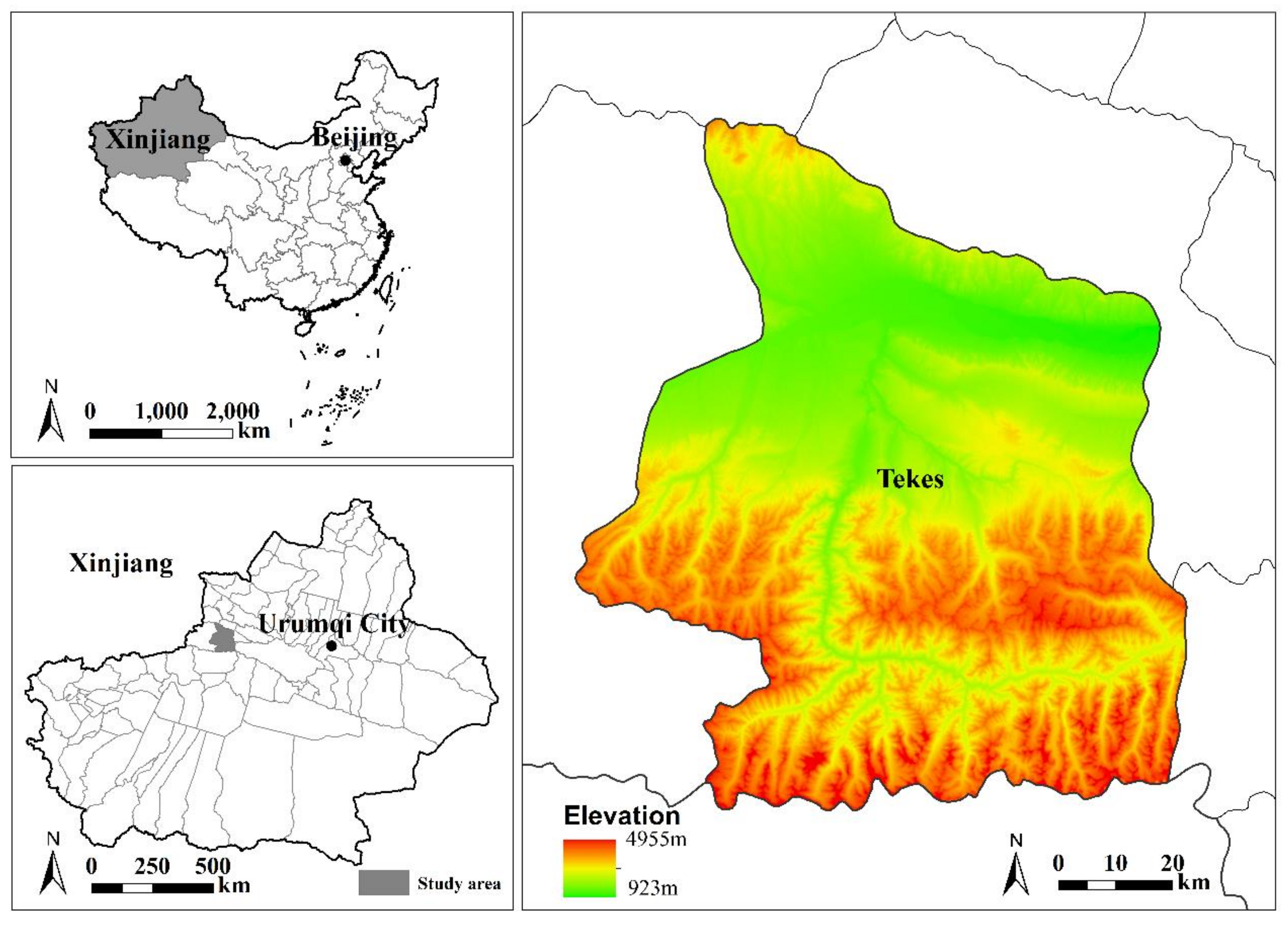
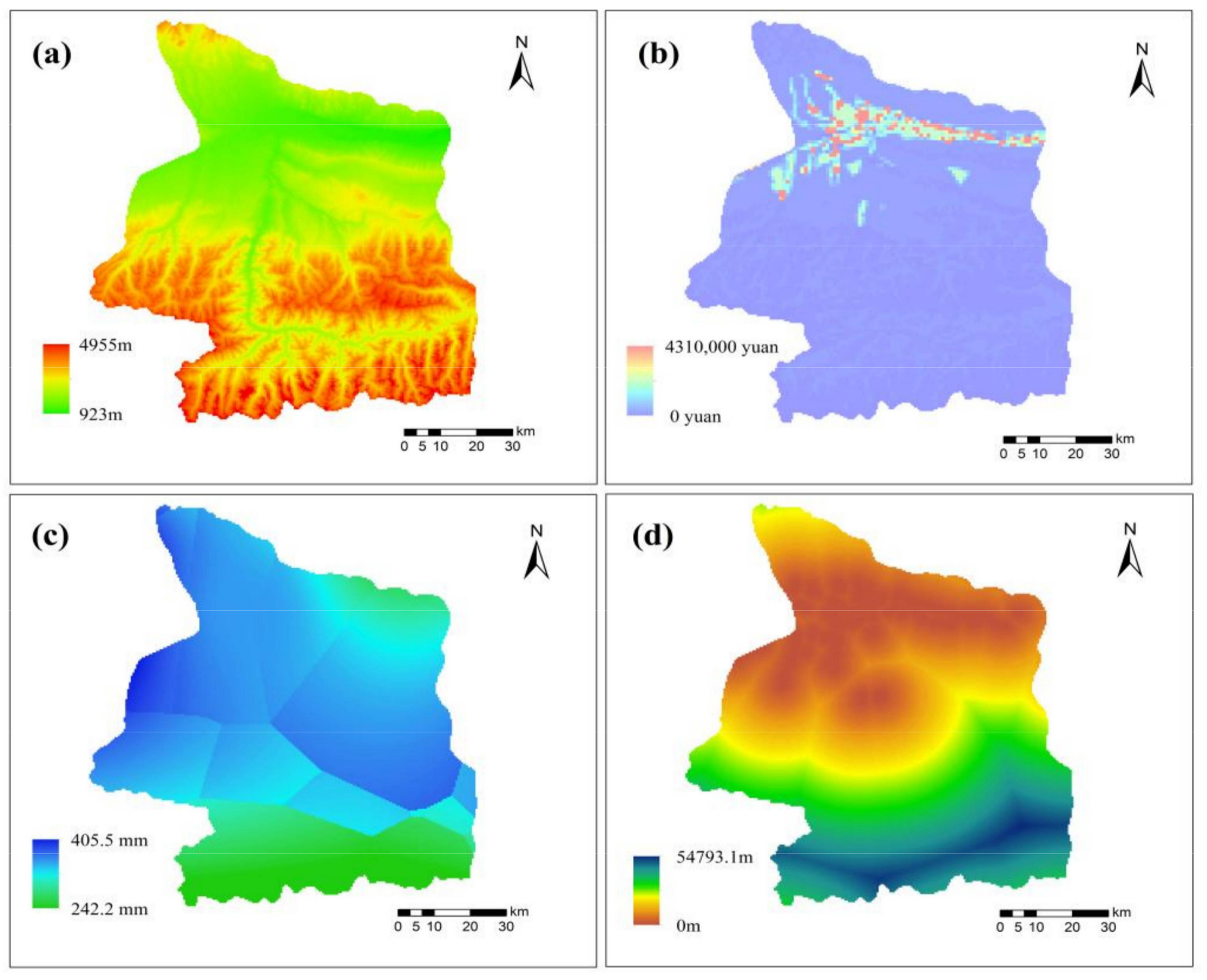
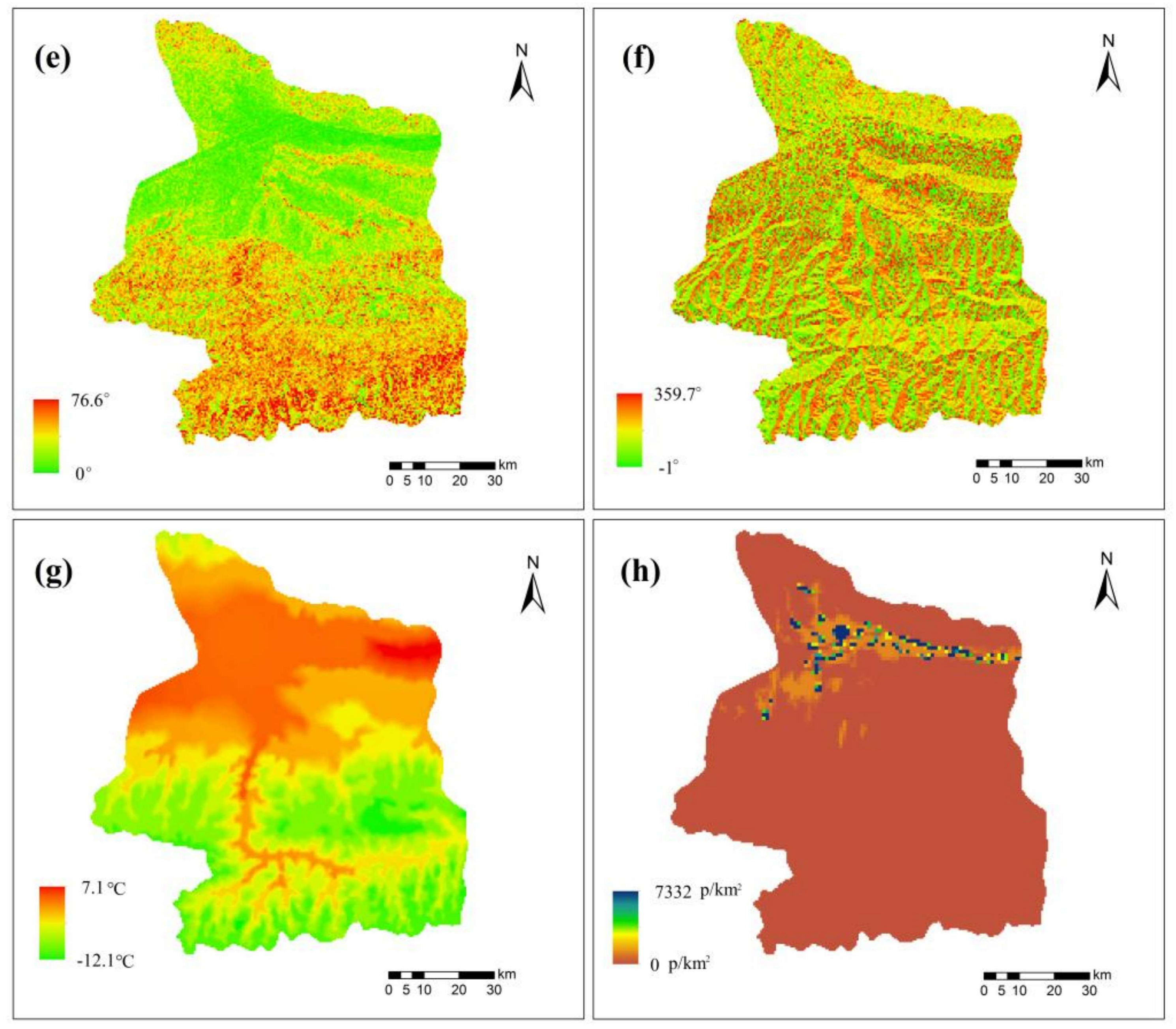
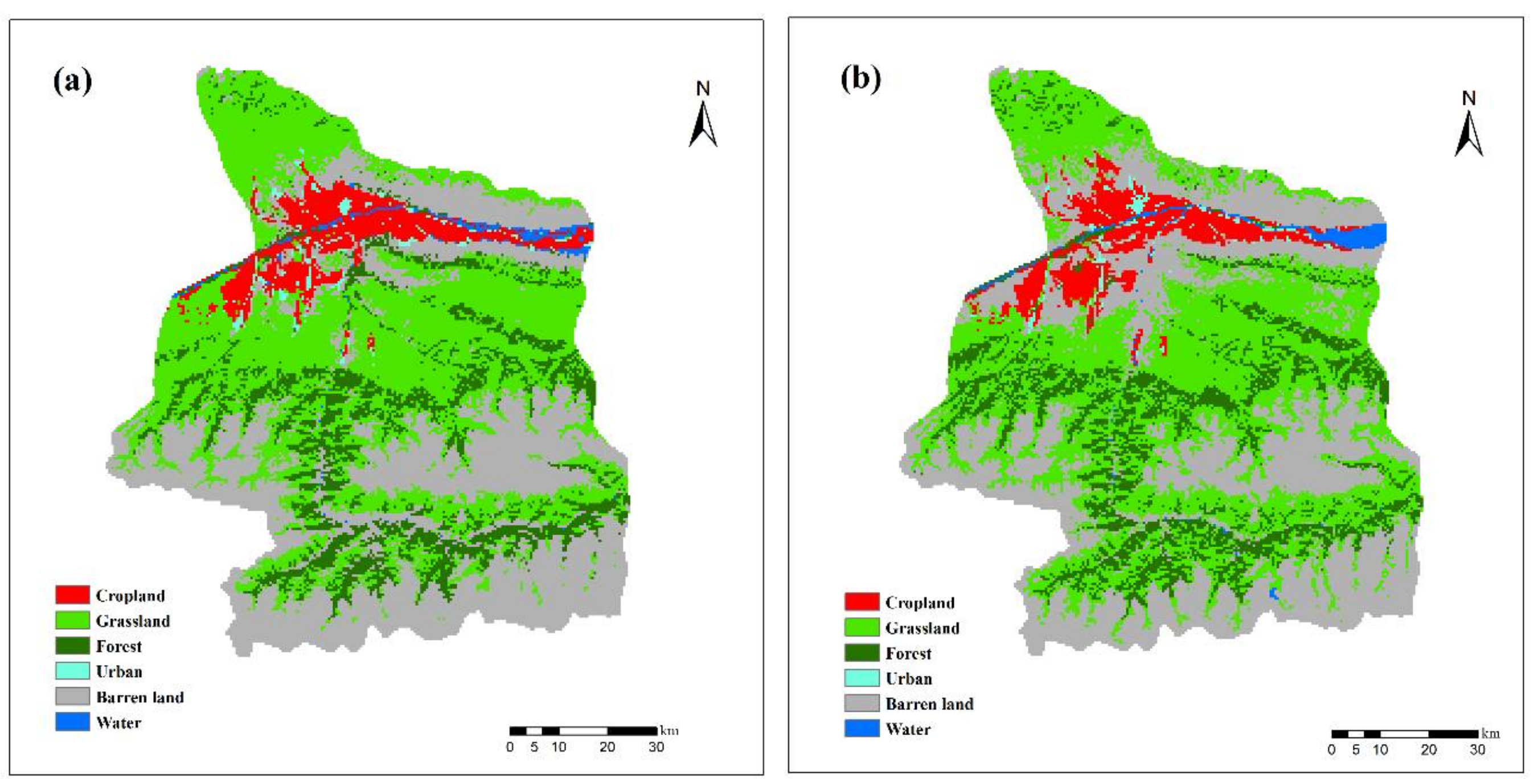
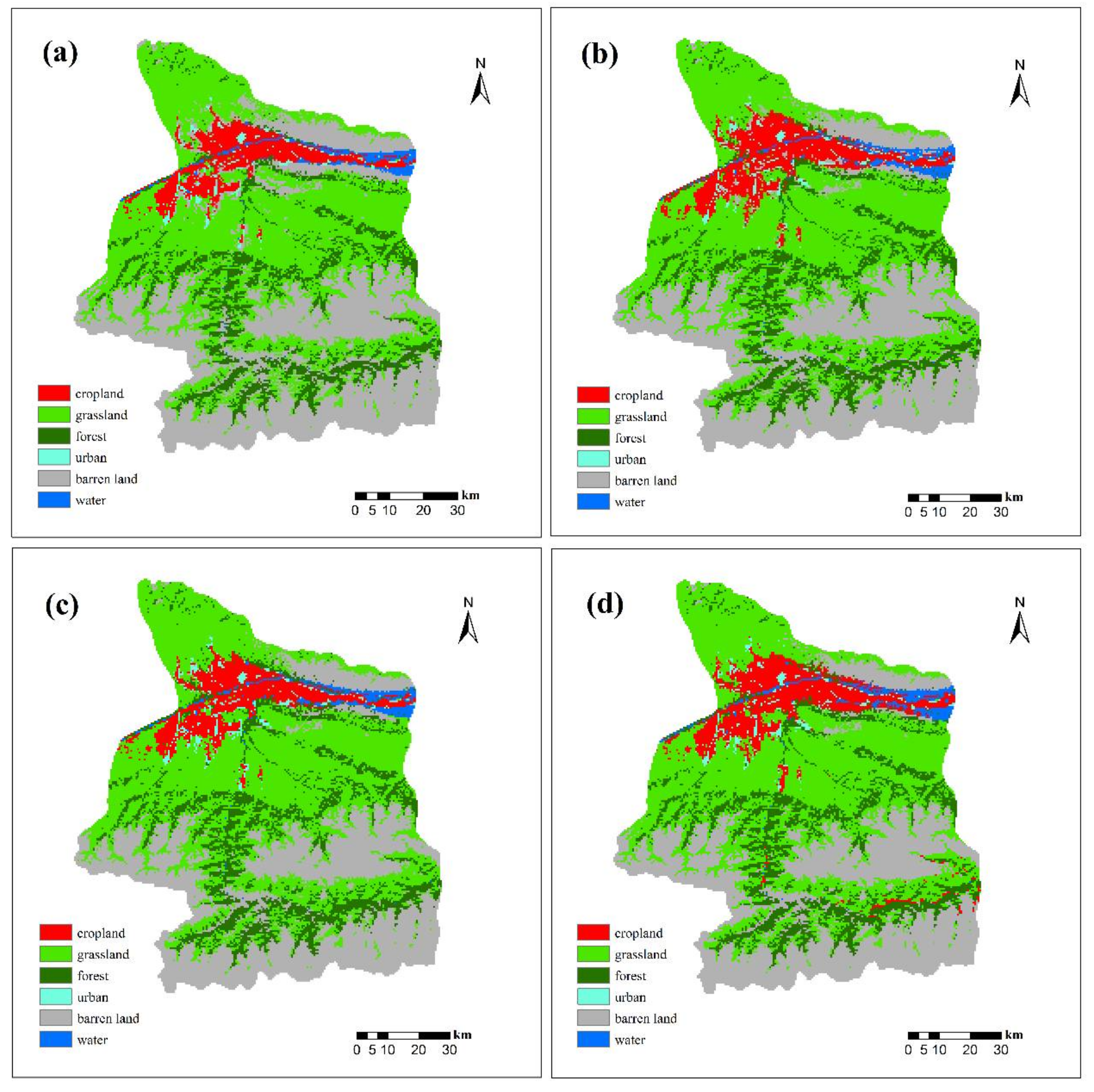
| Abbreviations | Description | Unit | Source of the Data |
|---|---|---|---|
| Tem | Annual temperature | °C | Database of natural resources of China (cell size 500 m) |
| Pre | Annual precipitation | mm | Database of natural resources of China (cell size 500 m) |
| Ele | Elevation | m | Digital elevation model (cell size 30 m) |
| Slp | Slope | % | Digital elevation model (cell size 30 m) |
| Asp | Aspect | ° | Digital elevation model (cell size 30 m) |
| Pop | Population density | p/km2 | Database of natural resources of China (2003, cell size 1000 m) |
| GDP | Gross domestic product | yuan | Database of natural resources of China (2003, cell size 1000 m) |
| Dis | Distance to the nearest resident | m | Base cartography of the study area (cell size 30 m) |
| Land Use | Cropland | Grassland | Forest | Urban | Barren Land | Water |
|---|---|---|---|---|---|---|
| Cropland | 1 | 1 | 1 | 1 | 1 | 1 |
| Grassland | 1 | 1 | 1 | 1 | 1 | 1 |
| Forest | 1 | 1 | 1 | 1 | 1 | 1 |
| Urban | 0 | 0 | 0 | 1 | 0 | 1 |
| Barren land | 1 | 1 | 1 | 1 | 1 | 1 |
| Water | 1 | 1 | 1 | 1 | 1 | 1 |
| Land Use Types | Cropland | Grassland | Forest | Urban | Barren Land | Water |
|---|---|---|---|---|---|---|
| ELAS parameters | 0.8 | 0.7 | 0.8 | 0.9 | 0.5 | 0.8 |
| Variables | Cropland | Grassland | Forest | Urban | Barren Land | Water |
|---|---|---|---|---|---|---|
| Elev | −0.0090 * | 0.0011 * | −0.0037 * | 0.0027 | 0.0016 * | −0.0036 |
| GDP | 0.0066 | −0.0625 * | −1.6022 * | 0.0022 | −0.0102 | 0.0156 |
| Pre | 0.0102 * | 0.0014 * | 0.0024 * | −0.0075 | −0.0028 * | −0.0013 |
| Dis | −0.0004 * | 0.00001 | 0.0001 * | −0.0026 ** | −0.0001 * | 0.0001 |
| Slp | −0.1378 * | −0.0119 ** | 0.0529 * | −0.2917 | 0.0076 | 0.0235 |
| Asp | −0.0009 | −0.0009 | 0.0025 * | 0.0038 | 0.0006 | −0.0041 |
| Temp | 0.0240 | 0.0256 * | −0.0111 | −0.0574 | −0.0104 | 0.0068 |
| Pop | −0.0004 | −0.1087 * | −0.0823 ** | 0.0004 | −0.0114 * | −0.0052 |
| Constant | −21.3680 | −7.5267 | −3.2211 | 21.7437 | 6.0701 | 3.6570 |
| ROC | 0.980 | 0.856 | 0.935 | 0.939 | 0.894 | 0.818 |
| Pseudo R2 | 0.893 | 0.417 | 0.509 | 0.326 | 0.511 | 0.138 |
| Year | Cropland | Grassland | Forest | Urban | Barren Land | Water |
|---|---|---|---|---|---|---|
| 2012 | 503.4 | 3389.3 | 1092.0 | 69.9 | 3183.2 | 101.5 |
| 2013 | 503.7 | 3408.1 | 1087.9 | 72.1 | 3165.2 | 105.4 |
| 2014 | 504.0 | 3427.0 | 1083.8 | 74.3 | 3147.2 | 109.4 |
| 2015 | 504.3 | 3446.0 | 1079.8 | 76.7 | 3129.4 | 113.5 |
| 2016 | 504.5 | 3465.2 | 1075.7 | 79.0 | 3111.7 | 117.8 |
| 2017 | 504.8 | 3484.4 | 1071.7 | 81.5 | 3094.0 | 122.2 |
| 2018 | 505.1 | 3503.7 | 1067.7 | 84.1 | 3076.5 | 126.9 |
| 2019 | 505.3 | 3503.7 | 1063.7 | 86.7 | 3059.1 | 131.7 |
| 2020 | 505.6 | 3523.2 | 1059.8 | 89.4 | 3041.7 | 136.6 |
| Scenarios | Cropland | Grassland | Forest | Urban | Barren Land | Water |
|---|---|---|---|---|---|---|
| 2011 | 504.3 | 3368.0 | 1151.0 | 69.5 | 3147.8 | 92.3 |
| Business as usual | 505.6 | 3523.2 | 1059.8 | 89.4 | 3041.7 | 136.6 |
| Cropland protection | 666.2 | 3580.6 | 1124.1 | 99.9 | 2706.2 | 149.9 |
| Ecological security | 582.9 | 3663.8 | 1249.0 | 99.9 | 2589.7 | 141.6 |
| Artificial modification | 749.4 | 3580.6 | 1165.8 | 99.9 | 2589.7 | 141.6 |
© 2018 by the authors. Licensee MDPI, Basel, Switzerland. This article is an open access article distributed under the terms and conditions of the Creative Commons Attribution (CC BY) license (http://creativecommons.org/licenses/by/4.0/).
Share and Cite
Zhang, Y.; Wang, P.; Wang, T.; Cai, C.; Li, Z.; Teng, M. Scenarios Simulation of Spatio-Temporal Land Use Changes for Exploring Sustainable Management Strategies. Sustainability 2018, 10, 1013. https://doi.org/10.3390/su10041013
Zhang Y, Wang P, Wang T, Cai C, Li Z, Teng M. Scenarios Simulation of Spatio-Temporal Land Use Changes for Exploring Sustainable Management Strategies. Sustainability. 2018; 10(4):1013. https://doi.org/10.3390/su10041013
Chicago/Turabian StyleZhang, Yu, Pengcheng Wang, Tianwei Wang, Chongfa Cai, Zhaoxia Li, and Mingjun Teng. 2018. "Scenarios Simulation of Spatio-Temporal Land Use Changes for Exploring Sustainable Management Strategies" Sustainability 10, no. 4: 1013. https://doi.org/10.3390/su10041013
APA StyleZhang, Y., Wang, P., Wang, T., Cai, C., Li, Z., & Teng, M. (2018). Scenarios Simulation of Spatio-Temporal Land Use Changes for Exploring Sustainable Management Strategies. Sustainability, 10(4), 1013. https://doi.org/10.3390/su10041013




